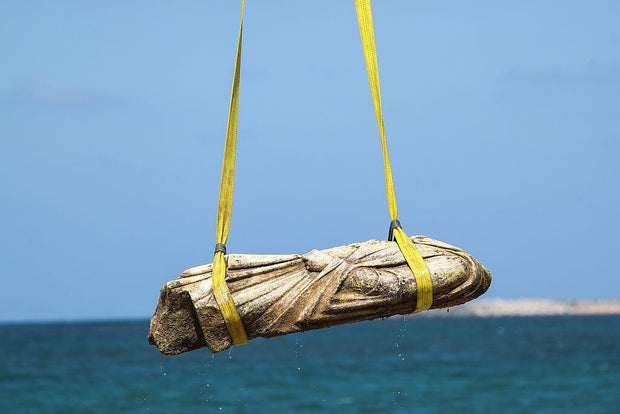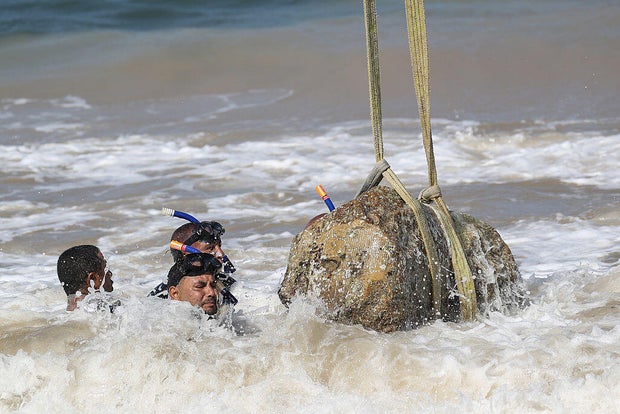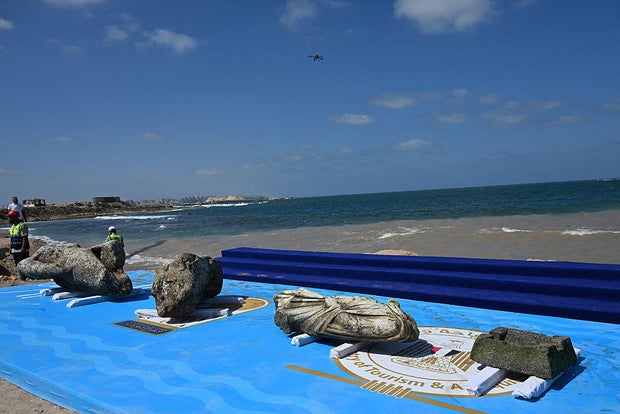Ancient statues, Roman coins and other artifacts from a sunken city were pulled from the Mediterranean Sea off the coast of Egypt Thursday.
The relics date back over 2,000 years. Egyptian authorities said the site, located in the waters of Abu Qir Bay near Alexandria, may be an extension of the ancient city of Canopus, a prominent center during the Ptolemaic dynasty, which ruled Egypt for nearly 300 years, and the Roman Empire, which governed for around 600 years.
Over time, a series of earthquakes and rising sea levels submerged the city and the nearby port city of Thonis-Heracleion, leaving behind a treasure trove of historical remains.
Khaled Desouki/AFP via Getty Images
On Thursday, cranes slowly hoisted statues from the depths, while divers in wetsuits, who had helped retrieve them, cheered from the shore.
“There’s a lot underwater, but what we’re able to bring up is limited, it’s only specific material according to strict criteria,” Egyptian Tourism and Antiquities Minister Sherif Fathi said. “The rest will remain part of our sunken heritage.”
Gehad Hamdy/picture alliance via Getty Images
The underwater ruins revealed by the ministry on Thursday include limestone buildings that may have served as places of worship, residential spaces and commercial or industrial structures.
Reservoirs and rock-carved ponds for domestic water storage and fish cultivation were also uncovered.
Other notable finds were statues of royal figures and sphinxes from the pre-Roman era, including a partially preserved sphinx with the cartouche of Ramses II, one of the country’s most famous and longest-ruling ancient pharaohs.
Gehad Hamdy/picture alliance via Getty Images
Many of the statues are missing body parts, including a beheaded Ptolemaic figure made of granite, and the lower half of a Roman nobleman’s likeness carved from marble.
A merchant ship, stone anchors and a harbour crane dating back to the Ptolemaic and Roman eras were found at the site of a 125-metre dock, which the ministry said was used as a harbour for small boats until the Byzantine period.
Amr Nabil / AP
Abu Qir Bay gained historical significance in 1859 when Egyptian Prince Oma Touson, along with fishermen and divers, found remains of ancient structures, according to Egypt’s Ministry of Tourism and Antiquities.
In addition to the sunken cities, multiple shipwrecks have been found in the bay. The ships include the wreckage of Napolean’s fleet from the 1798 Battle of the Nile, the ministry said. Napolean’s French fleet was defeated by a British fleet.
Khaled Desouki/AFP via Getty Images
Today, Alexandria is at risk of succumbing to the same waters that claimed Canopus and Thonis-Heracleion.
The coastal city is especially vulnerable to climate change and rising sea levels, sinking by more than three millimeters every year.
Even in the United Nations’ best-case scenario, a third of Alexandria will be underwater or uninhabitable by 2050.




